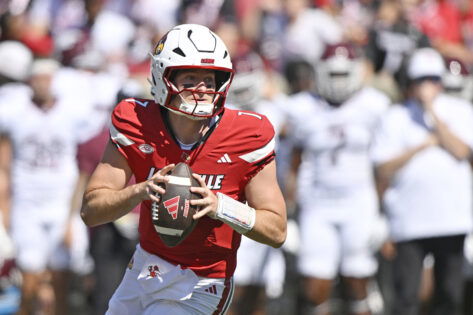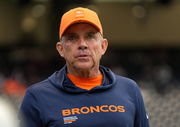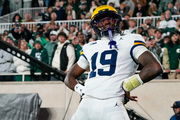
Imago
college football generic

Imago
college football generic
The AP poll rankings for Week 5 have just been released, and we have seen some dramatic shifts on the ladder. Starting with the top, Miami has moved up to No. 2, just behind Ohio State, after an ever-so-dominant win against the Gators. Oklahoma has surged to No. 7 after winning a one-score game against ranked Auburn; the eye test clearly favors the Sooners as Auburn fights the ‘10 sacks’ blemish. Illinois drops 14 places to No. 23 after an embarrassing demolition against Indiana, and Indiana gains 8 places to close their week 5 at No. 11.
Watch What’s Trending Now!
But two underrated teams were snubbed from the Top 25. One of which has already been mentioned above. These two had no business hanging outside the top 25. The teams are Auburn, which received 122 points (9 short of BYU, which stands at No. 25 ), and Louisville, with 25 points. Before we dive into the logic of why these teams were undeserving of being outside of the ranking, let’s go over two essential criteria based on which AP Poll voters usually cast their votes.
AP Polls’ website describes the voting process as, “The Top 25 voters are over 60 journalists covering college football for AP members and other news organizations. They’re urged to base their votes on head-to-head results, not reputation, preseason speculation, or regional bias.” The Polls clearly say that they are urged to make a decision on the head-to-head result. But that is not limited to just winning or losing. A part of head-to-head is the eye test, or the performance that the team puts up against another, regardless of the final result. So this gives us two criteria. 1) Win/loss status of a team. 2) Their performance on the field.
ADVERTISEMENT
Here’s where the problem arises. Let’s assume you’re a voter. How would you decide the ratio of these criteria on which you’d base your vote? That’s where the objectivity leaves the chat. In the majority of the settings, because we watch the game, we live the game, and we go through the lows and highs of the game, the performance on the field is given more weightage than the more important metric of win/loss. Let’s dive into how this connects to Auburn and Louisville performances.
Auburn’s snub makes no sense
Auburn’s only blemish this season has been this 24-17 loss against Oklahoma. They had a perfect run until this game, which included a win over Baylor. The game against Oklahoma was a one-score game, and interestingly, Auburn had a brief lead over them in the fourth quarter before the Sooners’ offense clinched it late. Jackson Arnold finished with 21-of-32 for 220 yards with a score, with good distribution to Cam Coleman (3 catches, 88 yards, TD) and Eric Singleton Jr. (9 catches, 60 yards). Jeremiah Cobb also rushed for 61 yards on just 6 carries.
ADVERTISEMENT
BREAKING: College Football AP Poll🚨 https://t.co/zcxbXhWcsk pic.twitter.com/BoOS0dm3SG
— On3 (@On3sports) September 21, 2025
The result matters, the performance matters, but the context matters more. Losing by 7 to an 11th-ranked team should not drop you out of the rankings. Oklahoma gained a total of four places; let’s normalize that to 2 places by taking out the teams that lost a place due to the bye week. Then Auburn should be losing like a place or at most two, and they should still be in the top 25.
ADVERTISEMENT
What’s more baffling is how Michigan is ranked and Auburn is not. Both are 3-1. Both have lost one to Oklahoma. Then there’s the question of what Notre Dame is doing in the top 25 with a 1-2 record. How do you make sense of these rankings? Auburn’s loss wasn’t a blowout. Until the dying seconds of the 4th quarter, the Tigers had a chance to level the score. How do you also not account for all the refereeing howlers that cost them the game?
Louisville got hard done by the rankings
Louisville’s case is much simpler than Auburn’s. They are 3-0 after a dominating win over Bowling Green in which the Cardinals controlled every front, even after battling frontline injuries and the limitations announced at the kickoff. It was disclosed that starting RB Issac Brown and star WR Chris Bell were limited in practice. Moreover, RB Duke Watson did not play. But even after these setbacks, Louisville outgained Bowling Green 452-321 using their depth and efficiency. Miller Moss was as clean and commanding as ever with 316 yards on 23-of-32 passing. Keyjuan Brown had 12 carries for 84 yards and two first-half touchdowns.
ADVERTISEMENT

Imago
NCAA, College League, USA Football: Eastern Kentucky at Louisville Aug 30, 2025 Louisville, Kentucky, USA Louisville Cardinals quarterback Miller Moss 7 looks to pass against the Eastern Kentucky Colonels during the first half at L&N Federal Credit Union Stadium. Louisville L&N Federal Credit Union Stadium Kentucky USA, EDITORIAL USE ONLY PUBLICATIONxINxGERxSUIxAUTxONLY Copyright: xJamiexRhodesx 20250830_sns_ar6_00181
But why are they still not cracking the Top 25? The voters may say that there isn’t ‘enough evidence’ to justify their place in the top 25. Is winning 3-0 enough evidence? Depends on the strength of the schedule. Okay, Louisville beat Eastern KY, James Madison, and Bowling Green. Is it enough evidence? The teams are not as strong, so no. But then why are Oregon and Penn State still in the top 10? They also haven’t had any real encounter against any good team; they still maintain their status quo.
Top Stories
Greg Biffle’s $4M Worth Prized Possession Still Without a Buyer Leaves NASCAR Fans Heartbroken

LIV Golf Braces for Another Possible Exit in Wake of Brooks Koepka Departure

Sean Payton Announces Retirement Plans as Broncos HC Demands Improvement From Bo Nix & Co. Before Playoffs

Biff Poggi All But Confirms Bryce Underwood’s Michigan Future After Announcing His Own Departure

Roger Federer Draws Criticism from Swiss Government Chief for Tourism Boom in Country

Amanda Balionis Confirms New Relationship Ending Months of Rumors

Is it fair for Louisville to be out of the Top 25? In our eyes? No. They are as much of a threat as any other team with Miller Moss and Jeff Brohm’s offensive combination, and they deserve to get to 24-25 at least. BYU is also at No. 25 after defeating three average teams. Before you come at us with Stanford comments, they’ve already given enough evidence of being an average team after being beaten by Hawaii. But, yes, we do see the logic in voters’ choices for this. The Cardinals had a 9-4 season last year, which is worse than Penn State’s/Oregon’s dominant season, so they might have to work a little harder to crack the Top 25.
ADVERTISEMENT
So, the bottom line is that Auburn should not be close to being ranked; they absolutely should be ranked. And Louisville, we offer a little flexibility on them, but they should’ve been ranked, too. Anyway, since the rankings are a comprehensive plethora of votes by a variety of voters, it actually tends towards the ‘standard mean of opinion’ of the group, which does not necessarily make the group right, but it certainly shows that the opinion might be a little popular.
ADVERTISEMENT
ADVERTISEMENT
ADVERTISEMENT

